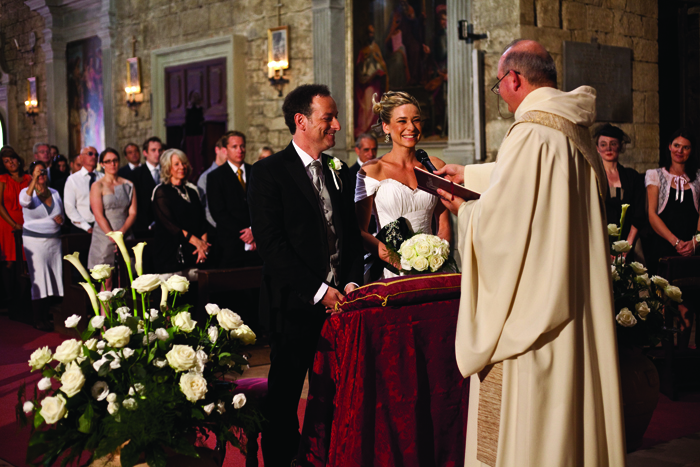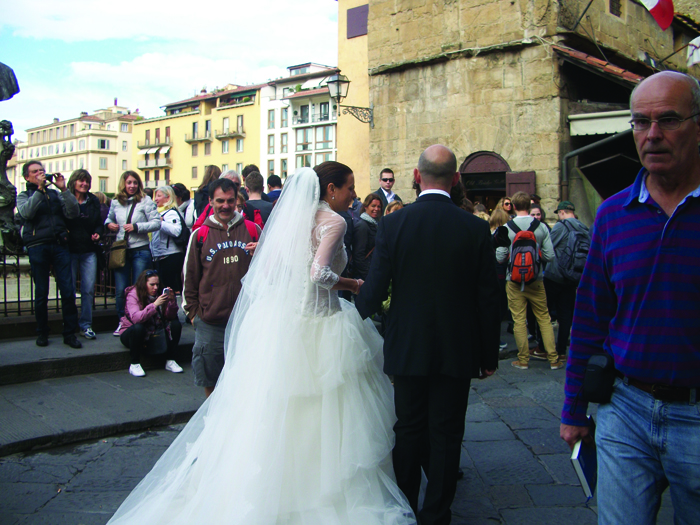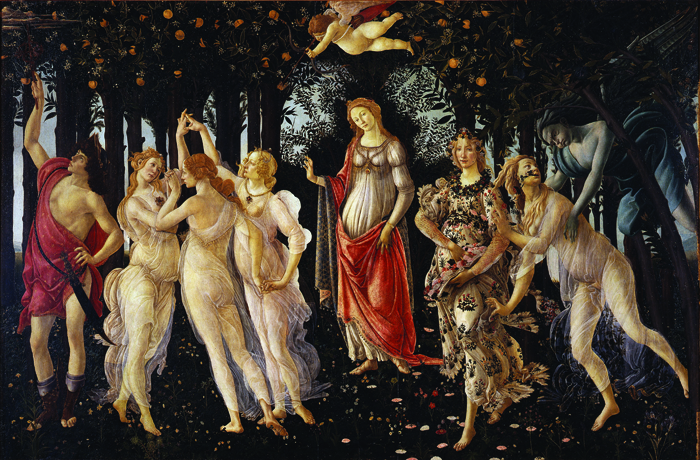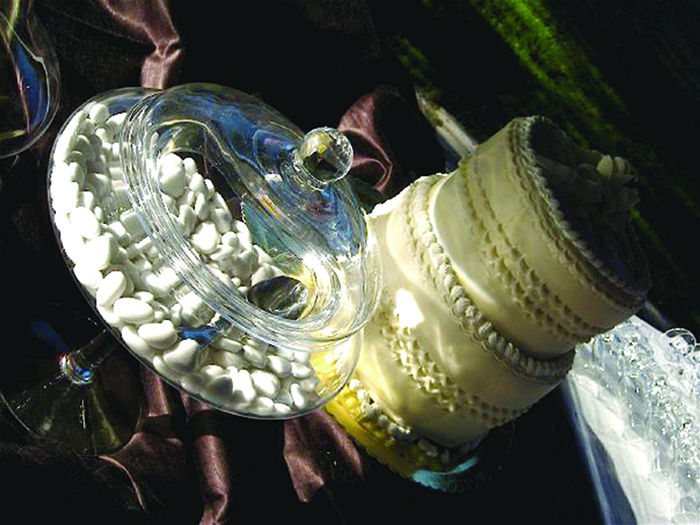Regular Italia! contributor Freya Middleton got married in Italy, and is therefore well placed to advise any who might be thinking of doing likewise. Here she tells all about Italian Weddings…
Italian weddings are fun, beautiful and elegant, and they always have excellent food and wine. Have I just stated the obvious? Don’t all weddings aim for exactly this? Yes they do; however, weddings in Tuscany have a distinct advantage: they are located in a country with some of the greatest wine and cuisine, and some of the most beautiful countryside, in the world, littered with centuries-old palaces and country estates built by the forebears of taste and etiquette for Western Europe, and which can be rented out and enjoyed by the wedding revellers. With all of this as the stage, scenery and props, if a few things do go pear-shaped, such as bad weather, wardrobe malfunctions or some badly behaved guests, the gala occasion is possibly weathered more smoothly here than elsewhere.

The general wedding schedule isn’t really much different to many other Western countries. There is a service with the exchanging of vows attended by family and friends and then a celebration. However, you would never be invited to an Italian wedding on a Friday or a Tuesday as the Italian proverb says “neither on Venus nor on Mars does one get married or depart” (né di venere né di marte non si sposa e non si parte), and if it rains on the day it probably wouldn’t dampen an Italian bride’s spirits much, as it is said that a wet bride will bring good luck (sposa bagnata, sposa fortunata).
I have found that engagement rings are not nearly as important as in the Anglo-Saxon world and, generally speaking, Italian couples exchange very simple, plain gold wedding rings. Wedding dresses are mostly white and mostly long and men are in suits. I have always been surprised at the really quite loud chit-chat that often takes place during the solemn ceremony at weddings. On numerous occasions I have shushed my husband and frowned at his friends when I think that it seems he and his mates are getting too carried away.

Wedding Planner
Michelle from Mya Wedding Planning (www.mya
wedding.com), a native Florentine and wedding planner by profession for both foreigners and Italians in Tuscany, says that you can tell straight away if the wedding is for an Italian couple or a foreign couple. A classic sign of an English wedding is of course the sea of hats, but she says that generally Italians are more traditional and use the traditional colours (white, green, red) whilst foreigners will experiment more with clothing (guests and the couple alike) and decorations, both in terms of colour and style. Planning time, she said, is on average six months for a foreign wedding, but double that for an Italian couple.
If the wedding is to be a Christian ceremony, then there are two readings. Paul’s First Letter to the Corinthians is an evergreen in Italy also. It is possible to have a mixed ceremony in a Catholic church in Italy where one person of the couple is Catholic and the other not. (However, my Kiwi mate, who married a Neapolitan in the only Protestant church in Naples, had to marry in the registry office before the ceremony in the church to make the whole thing legally binding.)
The bride and groom each choose witnesses (testimoni) to be at their side at the altar, normally two each, but more is possible (I had three). No matching attire is worn by the witnesses for this role. Exiting the church, it is common practice to pelt the newlyweds with rice, symbolically showering them with fortune for fertility and children. The speed and accuracy of the guests’ ability to get the rice in the bride’s hair and down the dress is impressive, but it is the force with which they do it that has always amazed me. It is no genteel act. The couple have to defend themselves with their arms and bouquets from the paddies being bestowed unto them by their dearest.

Civil Ceremonies
I got married in an 11th-century abbey in the Casentino area of Tuscany. If you like history, beauty and art, then the choice of beautiful places for the ceremony is impressive, with churches, chapels, abbeys, palaces and parks. The 13th century town hall (Palazzo Vecchio) of Florence has the ‘red room’ available (la sala rossa) for civil wedding ceremonies. Very popular for both foreign and local couples, there is always some traffic outside the room, the next couple and their entourage ready to enter at their allocated time slot. The room is atmospheric; with heavy red drapes, dark wood and tapestries, it lends itself well to the gravity and specialness of the occasion.
Afterwards, the feasting begins. Many nowadays opt for an abundant aperitivo (often outside) to ease into the more formal sit-down meal. Whilst people mill around and socialise, there are often ‘stations’ spread around the space, for salamis and cheese, for mises en bouches, for drinks. The fried vegetables are a personal favourite of mine: little pieces of lightly-battered fried aubergines, or onions, courgettes, carrots or mushrooms. I never eat fried food on any other occasion but these are so good that I had a station dedicated to this at my wedding, with an individual little deep fryer for instant delight.

The dinner, often three courses, will be some type of pasta followed by a second course and finally dessert. I do love the weddings that actually have the dessert stations also. Italians don’t do speeches – instead, the couple will do the rounds of the tables. Often, strangely, the couple have a table to themselves. It is customary to pay per head for the food and drinks together. Many companies will do a sample dinner with the meals and the wines a few months prior to the date and the aperitivo cost is based on how many stations are chosen. Michelle says that another telling sign of a foreign wedding is the amount of alcohol consumed, considerably more than at an Italian wedding.
Favours (bomboniere) are a must at an Italian wedding. Most commonly they are a bunch of white coloured sugared almonds (confetti) in a little pouch with the name of the happy couple and the date. A tradition dating back to ancient Roman times, sugared almonds (the Romans covered the almonds with honey and flour, not having sugar) are given in odd numbers of three or five, and symbolise abundance and prosperity. The cost of the confetti can differ considerably. The more expensive the confetti the better quality the almond and thinner the sugar shell. I am a confetti addict and I am displeased at the increasing fashion of mixing the almond confetti with the chocolate type.

The Honeymoon
Finally, for many years now, Italian couples opt not to have a registry list but to set up an account with a travel agency and guests contribute to the honeymoon, all organised on the internet directly with the travel agency. I did both as our Italian guests of a certain age were not comfortable nor familiar with giving money to the agency. We set up a registry at a well stocked homewares shop. This tradition of redecorating or furnishing a home for the newlyweds is of course centuries old. Raphael’s painting of Madonna of the Goldfinch in the Uffizi Gallery was commissioned as a gift on the occasion of the wedding between Lorenzo Nasi and Sandra di Matteo di Giovanni Canigiani in 1506. The same is true for the famous Botticelli mythological paintings of the Birth of Venus and Springtime, both thought to be commissioned by Lorenzo the Magnificent for his younger cousin Pier Francesco di Lorenzo on the occasion of his marriage in 1482.

Weddings of the Renaissance
And what was a wedding like in the Renaissance? The process differed slightly in each Italian city state. However, generally speaking, there were three main stages: the betrothal, the ring ceremony and the wedding celebration. Of course, very few alliances amongst the wealthy and influential families were love matches. They were a political, social and economical agreement between two families or clans. Lucrezia Tornabuoni chose Clarice Orsini for the wife for her eldest son, Lorenzo the Magnificent, because her family was one of the most influential and oldest families in Roman society. It was the first Medici match outside of Florence and a significant move to increase their international standing. The betrothal (agiuramento) was when the families met to sign the marriage contract stipulating the daughter’s dowry (money, property, jewellery) that she would bring to party and the specific marriage conditions. In turn, Lorenzo the Magnificent organised the marriage of one of his daughters, Maddelena, to the son of Pope Innocent VIII, Francesco Cybo, and through this convenient contract he managed to seal the first cardinalate for the Medici family. Lorenzo’s son, Giovanni was made cardinal at 13 by Pope Innocent VIII – that would have cost him quite a sum. Marriage has been big business and high stakes since time immemorial. In Florence in 1425, and then later elsewhere in Italy, the dowry bank (Monte delle doti) was created, where parents would make steady deposits over the years, accruing interest, to ensure a sizeable sum when the daughter was of marriageable age, usually from 14 years old. Wealthy merchants would also donate dowries to poor girls as an act of piety.
The ring ceremony made the alliance public. The exchange of rings happened at the bride’s home. Diamond was a common stone used and the ring finger on the right hand seems to be the finger of choice, only to change hands after the Reformation. The use of the ‘ring finger’ for the wedding ring dates to an ancient belief that a vein from this finger ran straight to the heart; it was mentioned again in the 7th century in Isidore of Seville’s Etymologiae. Interestingly, until the Council of Trent (concluded in 1563) the exchange of rings and the couple’s consent was a civil ceremony. Afterwards, the council officially required that Catholic marriages be presided over by a priest.

The Wedding Party
The third and final stage of the marriage takes place with the wedding party (nozze). The festivities lasted three days for Lorenzo the Magnificent’s party held at the Palazzo Medici-Riccardi. There were five banquets with 150 calves and 4,000 capons brought in for the catering, along with local and international wine and 17 tonnes of sweetmeats and sugared almonds. The only document we have locating the bronze statue of David by Donatello in the centre of the courtyard of this palazzo is a letter from one of the guests describing the event. There was entertainment organised throughout the event, a battle staged and allegorical floats and plays performed in the garden.
After the ring ceremony, the bride would bring many new items to the new house. Often there was a parade from her house to the groom’s displaying the expensive fabrics and items in the procession. However, sumptuary laws which limited certain ostentatious display rendered wooden chests more and more important, which in turn increased their importance of presence. These cassoni (often called forzieri in Florence) were often beautifully carved and painted with scenes relative to the festive event. These chests were then used as storage in the new home and seating. Later, the painted scenes were cut from their setting and placed elsewhere. Botticelli painted a wonderful reclining Venus and Mars, now in the National Gallery, London, which art historians have concluded was originally from a cassone or used as a spalliera. From the word for shoulders (spalle), a spalliera was a wall panel placed at shoulder height. This was the same presumed function of Botticelli’s Primavera, pictured on the previous page.
Weddings have always been big business in Tuscany and celebrities and romantics of all nationalities, I have no doubt, will continue to plan their special day in this little piece of paradise.

